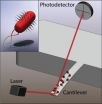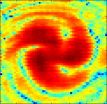(Press-News.org) Cambridge, Mass. – September 16, 2014 – Silicon has few serious competitors as the material of choice in the electronics industry. Yet transistors, the switchable valves that control the flow of electrons in a circuit, cannot simply keep shrinking to meet the needs of powerful, compact devices; physical limitations like energy consumption and heat dissipation are too significant.
Now, using a quantum material called a correlated oxide, Harvard researchers have achieved a reversible change in electrical resistance of eight orders of magnitude, a result the researchers are calling "colossal." In short, they have engineered this material to perform comparably with the best silicon switches.
The finding arose in what may seem an unlikely spot: a laboratory usually devoted to studying fuel cells—the kind that run on methane or hydrogen—led by Shriram Ramanathan, Associate Professor of Materials Science at the Harvard School of Engineering and Applied Sciences (SEAS). The researchers' familiarity with thin films and ionic transport enabled them to exploit chemistry, rather than temperature, to achieve the dramatic result.
Because the correlated oxides can function equally well at room temperature or a few hundred degrees above it, it would be easy to integrate them into existing electronic devices and fabrication methods. The discovery, published in Nature Communications, therefore firmly establishes correlated oxides as promising semiconductors for future three-dimensional integrated circuits as well as for adaptive, tunable photonic devices.
Challenging silicon
Although electronics manufacturers continue to pack greater speed and functionality into smaller packages, the performance of silicon-based components will soon hit a wall.
"Traditional silicon transistors have fundamental scaling limitations," says Ramanathan. "If you shrink them beyond a certain minimum feature size, they don't quite behave as they should."
Yet silicon transistors are hard to beat, with an on/off ratio of at least 10^4 required for practical use. "It's a pretty high bar to cross," Ramanathan explains, adding that until now, experiments using correlated oxides have produced changes of only about a factor of 10, or 100 at most, near room temperature. But Ramanathan and his team have crafted a new transistor, made primarily of an oxide called samarium nickelate, that in practical operation achieves an on/off ratio of greater than 10^5—that is, comparable to state-of-the-art silicon transistors.
In future work the researchers will investigate the device's switching dynamics and power dissipation; meanwhile, this advance represents an important proof of concept.
"Our orbital transistor could really push the frontiers of this field and say, you know what? This is a material that can challenge silicon," Ramanathan says.
Solid-state chemical doping
Materials scientists have been studying the family of correlated oxides for years, but the field is still in its infancy, with most research aimed at establishing the materials' basic physical properties.
"We have just discovered how to dope these materials, which is a foundational step in the use of any semiconductor," says Ramanathan.
Doping is the process of introducing different atoms into the crystal structure of a material, and it affects how easily electrons can move through it—that is, to what extent it resists or conducts electricity. Doping typically effects this change by increasing the number of available electrons, but this study was different. The Harvard team manipulated the band gap, the energy barrier to electron flow.
"By a certain choice of dopants—in this case, hydrogen or lithium—we can widen or narrow the band gap in this material, deterministically moving electrons in and out of their orbitals," Ramanathan says. That's a fundamentally different approach than is used in other semiconductors. The traditional method changes the energy level to meet the target; the new method moves the target itself.
In this orbital transistor, protons and electrons move in or out of the samarium nickelate when an electric field is applied, regardless of temperature, so the device can be operated in the same conditions as conventional electronics. It is solid-state, meaning it involves no liquids, gases, or moving mechanical parts. And, in the absence of power, the material remembers its present state—an important feature for energy efficiency.
"That's the beauty of this work," says Ramanathan. "It's an exotic effect, but in principle it's highly compatible with traditional electronic devices."
Quantum materials
Unlike silicon, samarium nickelate and other correlated oxides are quantum materials, meaning that quantum-mechanical interactions have a dominant influence over the material properties—and not just at small scales.
"If you have two electrons in adjacent orbitals, and the orbitals are not completely filled, in a traditional material the electrons can move from one orbital to another. But in the correlated oxides, the electrons repulse each other so much that they cannot move," Ramanathan explains. "The occupancy of the orbitals and the ability of electrons to move in the crystal are very closely tied together—or 'correlated.' Fundamentally, that's what dictates whether the material behaves as an insulator or a metal."
Ramanathan and others at SEAS have successfully manipulated the metal-insulator transition in vanadium oxide, too. In 2012, they demonstrated a tunable device that can absorb 99.75% of infrared light, appearing black to infrared cameras.
Similarly, samarium nickelate is likely to catch the attention of applied physicists developing photonic and optoelectronic devices.
"Opening and closing the band gap means you can now manipulate the ways in which electromagnetic radiation interacts with your material," says Jian Shi, lead author of the paper in Nature Communications. He completed the research as a postdoctoral fellow in Ramanathan's lab at Harvard SEAS and joined the faculty of Rensselaer Polytechnic Institute this fall. "Just by applying an electric field, you're dynamically controlling how light interacts with this material."
Further ahead, Researchers at the Center for Integrated Quantum Materials, established at Harvard in 2013 through a grant from the National Science Foundation, aim to develop an entirely new class of quantum electronic devices and systems that will transform signal processing and computation.
Ramanathan compares the current state of quantum materials research to the 1950s, when transistors were newly invented and physicists were still making sense of them. "We are basically in that era for these new quantum materials," he says. "This is an exciting time to think about establishing the basic, fundamental properties. In the coming decade or so, this could really mature into a very exciting device platform."
INFORMATION:
You Zhou, a graduate student at Harvard SEAS, was co-lead author of the paper in Nature Communications. The research was supported by grants from the National Science Foundation (NSF) (CCF-0926148) and the National Academy of Sciences, as well as an NSF Faculty Early Career Development (CAREER) Award to Prof. Ramanathan (DMR-0952794).
For electronics beyond silicon, a new contender emerges
New transistor achieves 'colossal' switchable resistance using quantum materials and physics developed in a fuel cell lab
2014-09-16
ELSE PRESS RELEASES FROM THIS DATE:
NASA's Global Hawk and satellites investigating Hurricane Edouard today
2014-09-16
The unmanned Global Hawk aircraft that's part of NASA's airborne Hurricane and Severe Storm Sentinel, or HS3 mission was winging its way to Hurricane Edouard on September 16. In addition to the Global Hawk, various NASA satellites are continually providing data on the Atlantic hurricane.
Scientific instruments aboard NASA's remotely piloted Global Hawk aircraft have been studying the hurricane over the last couple of days, and the Global Hawk returned to Edouard again today, September 16. Two of the instruments aboard the Global Hawk that will study Edouard are the S-HIS ...
Cancer patients with malignant spinal cord compression have preserved mobility
2014-09-16
San Francisco, September 15, 2014—Mobility is equally preserved in cancer patients suffering from malignant spinal cord compression (MSCC) who receive a single dose of 10 Gy of radiation therapy (RT), compared to patients who receive five daily doses of 4 Gy of RT each, according to research presented today at the American Society for Radiation Oncology's (ASTRO's) 56th Annual Meeting.
Malignant spinal cord compression (MSCC) is a complication of metastatic cancer mostly with bone involvement that occurs when a tumor's secondary deposit presses on the spinal cord and ...
And so they beat on, flagella against the cantilever
2014-09-16
WASHINGTON D.C., September 16, 2014 – A team of researchers at Boston University and Stanford University School of Medicine has developed a new model to study the motion patterns of bacteria in real time and to determine how these motions relate to communication within a bacterial colony.
The researchers chemically attached colonies of Escherichia coli bacteria to a microcantilever – a microscopic beam anchored at one end, similar to a diving board – thus coupling its motion to that of the bacteria. As the cantilever itself isn't doesn't generate any vibrations, or 'noise,' ...
NASA sees Tropical Storm Odile knocking at US Southwest
2014-09-16
Tropical Storm Odile continues to drench western Mexico and has now entered into the U.S. Southwest. On September 15, NASA's Terra satellite saw Odile's northernmost edge crossing the Mexican border into southern California. NOAA's GOES-East satellite on September 16 showed Odile's outer bands were already bringing storms to southern Arizona.
NASA Sees Odile Knocking on U.S. Border
On Sept. 15 at 2:35 p.m. EDT, the Moderate Resolution Imaging Spectroradiometer instrument aboard NASA's Terra satellite saw the northern fringes of Hurricane Odile straddling the border ...
Scientists twist radio beams to send data
2014-09-16
Building on previous research that twisted light to send data at unheard-of speeds, scientists at USC have developed a similar technique with radiowaves, reaching high speeds without some of the hassles that can go with optical systems.
The researchers, led by electrical engineering professor Alan Willner of the USC Viterbi School of Engineering, reached data transmission rates of 32 gigabits per second across 2.5 meters of free space in a basement lab at USC.
For reference, 32 gigabits per second is fast enough to transmit more than 10 hour-and-a-half-long HD movies ...
Kessler Foundation scientists link slowed processing speed with executive deficits in MS
2014-09-16
West Orange, NJ. September 16, 2014. Kessler Foundation researchers have published a study supporting the role of slowed processing speed in the executive deficits found in individuals with multiple sclerosis (MS). "Does slowed processing speed account for executive deficits in multiple sclerosis? Evidence from neuropsychological performance and structural neuroimaging," was published online ahead of print on August 18 by Rehabilitation Psychology The authors are Victoria Leavitt, PhD, of the Manhattan Memory Center, formerly of Kessler Foundation. Co-authors are Foundation ...
Tornadoes occurring earlier in 'Tornado Alley'
2014-09-16
WASHINGTON, D.C. – Peak tornado activity in the central and southern Great Plains of the United States is occurring up to two weeks earlier than it did half a century ago, according to a new study whose findings could help states in "Tornado Alley" better prepare for these violent storms.
Tornado records from Nebraska, Kansas, Oklahoma, and northern Texas – an area of high tornado activity dubbed "Tornado Alley" -- show that peak tornado activity is starting and ending earlier than it did 60 years ago.
Peak tornado activity, which occurs in the region from early ...
Water-based nuclear battery developed by MU can be used to generate electrical energy
2014-09-16
COLUMBIA, Mo. – From cell phones to cars and flashlights, batteries play an important role in everyday life. Scientists and technology companies constantly are seeking ways to improve battery life and efficiency. Now, for the first time using a water-based solution, researchers at the University of Missouri have created a long-lasting and more efficient nuclear battery that could be used for many applications such as a reliable energy source in automobiles and also in complicated applications such as space flight.
"Betavoltaics, a battery technology that generates power ...
Patients waiting too long to see doctor? Try 'just-in-time' management methods, researchers urge
2014-09-16
Using a pain clinic as a testing ground, researchers at Johns Hopkins have shown that a management process first popularized by Toyota in Japan can substantially reduce patient wait times and possibly improve the teaching of interns and residents.
In a report on the pilot study, published online Sept. 9, in Pain Medicine, the researchers adopted the so-called "Just-in-Time" training and inventory process used now by many manufacturers and service industries to stem waste and keep complicated operations from bottlenecking.
"We realized that a significant amount of time ...
Study on global carbon cycle may require reappraisal of climate events in Earth's history
2014-09-16
MIAMI – A recent study of the global carbon cycle offers a new perspective of Earth's climate records through time. Scientists at the University of Miami (UM) Rosenstiel School of Marine and Atmospheric Science suggest that one of the current methods for interpreting ancient changes in the concentration of carbon dioxide in the atmosphere and oceans may need to be re-evaluated.
The UM Rosenstiel School researchers measured the abundance of carbon-12 and carbon-13 isotopes in both the organic matter and carbonate sediments found in a nearly 700-meter marine sediment core ...
LAST 30 PRESS RELEASES:
Numbers in our sights affect how we perceive space
SIMJ announces global collaborative book project in commemoration of its 75th anniversary
Air pollution exposure and birth weight
Obstructive sleep apnea risk and mental health conditions among older adults
How talking slows eye movements behind the wheel
The Ceramic Society of Japan’s Oxoate Ceramics Research Association launches new international book project
Heart-brain connection: international study reveals the role of the vagus nerve in keeping the heart young
Researchers identify Rb1 as a predictive biomarker for a new therapeutic strategy in some breast cancers
Survey reveals ethical gaps slowing AI adoption in pediatric surgery
Stimulant ADHD medications work differently than thought
AI overestimates how smart people are, according to HSE economists
HSE researchers create genome-wide map of quadruplexes
Scientists boost cell "powerhouses" to burn more calories
Automatic label checking: The missing step in making reliable medical AI
Low daily alcohol intake linked to 50% heightened mouth cancer risk in India
American Meteorological Society announces Rick Spinrad as 2026 President-Elect
Biomass-based carbon capture spotlighted in newly released global climate webinar recording
Illuminating invisible nano pollutants: advanced bioimaging tracks the full journey of emerging nanoscale contaminants in living systems
How does age affect recovery from spinal cord injury?
Novel AI tool offers prognosis for patients with head and neck cancer
Fathers’ microplastic exposure tied to their children’s metabolic problems
Research validates laboratory model for studying high-grade serous ovarian cancer
SIR 2026 delivers transformative breakthroughs in minimally invasive medicine to improve patient care
Stem Cell Reports most downloaded papers of 2025 highlight the breadth and impact of stem cell research
Oxford-led study estimates NHS spends around 3% of its primary and secondary care budget on the health impacts of heat and cold in England
A researcher’s long quest leads to a smart composite breakthrough
Urban wild bees act as “microbial sensors” of city health.
New study finds where you live affects recovery after a hip fracture
Forecasting the impact of fully automated vehicle adoption on US road traffic injuries
Alcohol-related hospitalizations from 2016 to 2022
[Press-News.org] For electronics beyond silicon, a new contender emergesNew transistor achieves 'colossal' switchable resistance using quantum materials and physics developed in a fuel cell lab







